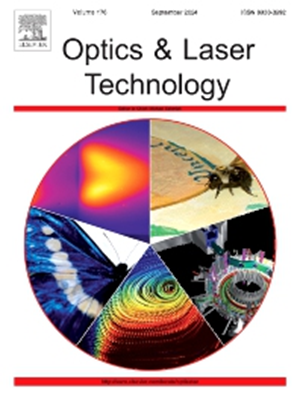基于低噪声倍频绿色激光的高稳定水下频率传输
IF 4.6
2区 物理与天体物理
Q1 OPTICS
引用次数: 0
摘要
提出并论证了一种基于低噪声倍频绿色激光的水下频率传输方案。采用1018 nm低噪声窄线宽种子激光对500 MHz微波频率信号进行调制,种子激光倍频至509 nm,验证了倍频过程中引入的附加噪声足够低,可以实现微波频率参考信号的低噪声电光转换。同时,采用电子相位补偿技术对传输噪声进行补偿。实现了8 m水下链路上参考频率信号的高精度传输。实验结果表明,分数阶频率不稳定性分别为5.5 × 10−14 @ 1 s和1.7 × 10−16 @ 1000 s。总均方根时延波动约为288 fs。通过该方案,水下频率传输的分数阶频率不稳定性达到10 ~ 14阶,满足高性能氢钟等的频率传输要求。该方法在水下时空参考和分布式传感器网络中具有重要的应用前景。本文章由计算机程序翻译,如有差异,请以英文原文为准。
High-stability underwater frequency transmission based on low noise frequency doubled green laser
An underwater frequency transmission scheme based on low noise frequency doubled green laser was proposed and demonstrated. The 500 MHz microwave frequency signal was modulated by 1018 nm narrow-linewidth seed laser with low noise and seed laser frequency doubling to 509 nm, which verified that the additional noise introduced in the frequency-doubling process was low enough to realize the low noise electro-optic conversion of microwave frequency reference signals. Meanwhile, the transmission noise was compensated with electronic phase compensation technique. Then the frequency reference signal transmitted over 8 m underwater link with high precision was realized. The experimental results showed that the fractional frequency instability was 5.5 × 10−14 @ 1 s, 1.7 × 10−16 @ 1000 s, respectively. The total root-mean-square timing delay fluctuation was about 288 fs. By the scheme, the fractional frequency instability of underwater frequency transmission reached to 10−14 orders, which met the frequency transmission requirements of high-performance hydrogen clocks, etc. The method would have important application prospect in underwater space–time reference and distributed sensor network.
求助全文
通过发布文献求助,成功后即可免费获取论文全文。
去求助
来源期刊
CiteScore
8.50
自引率
10.00%
发文量
1060
审稿时长
3.4 months
期刊介绍:
Optics & Laser Technology aims to provide a vehicle for the publication of a broad range of high quality research and review papers in those fields of scientific and engineering research appertaining to the development and application of the technology of optics and lasers. Papers describing original work in these areas are submitted to rigorous refereeing prior to acceptance for publication.
The scope of Optics & Laser Technology encompasses, but is not restricted to, the following areas:
•development in all types of lasers
•developments in optoelectronic devices and photonics
•developments in new photonics and optical concepts
•developments in conventional optics, optical instruments and components
•techniques of optical metrology, including interferometry and optical fibre sensors
•LIDAR and other non-contact optical measurement techniques, including optical methods in heat and fluid flow
•applications of lasers to materials processing, optical NDT display (including holography) and optical communication
•research and development in the field of laser safety including studies of hazards resulting from the applications of lasers (laser safety, hazards of laser fume)
•developments in optical computing and optical information processing
•developments in new optical materials
•developments in new optical characterization methods and techniques
•developments in quantum optics
•developments in light assisted micro and nanofabrication methods and techniques
•developments in nanophotonics and biophotonics
•developments in imaging processing and systems

 求助内容:
求助内容: 应助结果提醒方式:
应助结果提醒方式:


